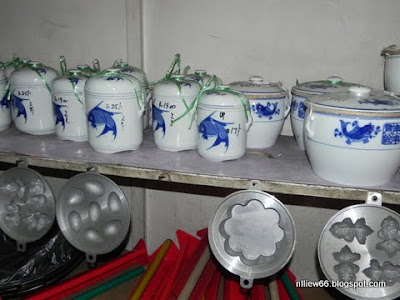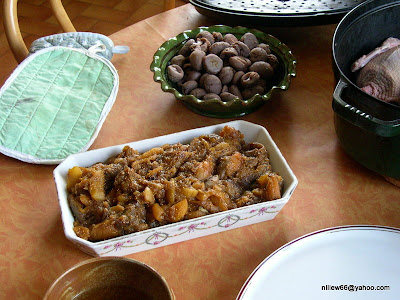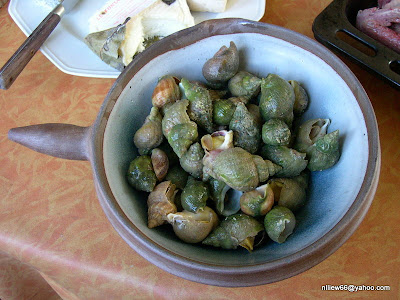How many people these days actually know what exactly is a crockery shop? Or precisely, how many crockery shops are there left around? Well, there still exist one in Raub, a real crockery shop by origin where the shop really started life by selling what else but crockery. Well, back in 1925 when the shop was founded, there weren't any Carrefour, Tesco, JayaJusco nor local supermarkets that eclipsed the function of a crockery shop - selling pots, pans, porcelains, kitchen utensils and the likes. I was refurbishing my kitchen and I wanted some retro-styled bowls and plates so the first thing that came across my mind was BEE WOH! Many years back, I remember having bought some old-fashioned cockerel bowls as well as blue-and-white rice bowls from the shop. It was manned by two elderly sisters, grand-daughters of the original founders. Gone are the really old stock - the sisters told me that few years back, some foreigners 'kwei-lows' bought the whole old stock and even asked if they would part with their old safe imported from old England! Well, I managed to buy a few large cockerel bowls of much inferior quality (in term of drawing details) but they are still authentic hand-drawn porcelain bowls...if ever anyone should visit Raub and is fascinated by trivialities, why not Bee Woh for a glimpse of the old Malaya...
 Cockerel bowls : porcelain bowls much used in the olden days by hawkers and coffee shops for our beloved wanton noodle soups, laksa (noodles in curry broth) and Bak Kut Teh (spicy pork soup), sadly now replacedby colourful and toxic melanin and plastic bowls.
Cockerel bowls : porcelain bowls much used in the olden days by hawkers and coffee shops for our beloved wanton noodle soups, laksa (noodles in curry broth) and Bak Kut Teh (spicy pork soup), sadly now replacedby colourful and toxic melanin and plastic bowls. Guess what, the last few remaining porcelain tea cups in the shop. It is synonymous with the Hainanese coffee shops found all over Malaya, later the young Malaysia. This particular design is an institution and a culture in itself.
Guess what, the last few remaining porcelain tea cups in the shop. It is synonymous with the Hainanese coffee shops found all over Malaya, later the young Malaysia. This particular design is an institution and a culture in itself. Pictures of the first-generation shopkeepers - parents of the elderly sisters still manning the shop.
Pictures of the first-generation shopkeepers - parents of the elderly sisters still manning the shop. Back in the olden days, prizes were given for exemplary behaviours during National Day celebration. It was a very different Malaysia back then. The shop was conferred a certificate of cleanliness, a far cry from its current state of existence now...
Back in the olden days, prizes were given for exemplary behaviours during National Day celebration. It was a very different Malaysia back then. The shop was conferred a certificate of cleanliness, a far cry from its current state of existence now... An old photo on the wall, depicting the Government servants club of Bentong of which the last owner was a member.
An old photo on the wall, depicting the Government servants club of Bentong of which the last owner was a member. Clay pots for making soups the old-fashioned way - by using a charcoal stove. This kind of clay pot will not stand direct gas fire.
Clay pots for making soups the old-fashioned way - by using a charcoal stove. This kind of clay pot will not stand direct gas fire. Wooden clogs!... what nostalgia. When I was a boy, there was an elderly bespectacled clog maker in my village and I used to go to his shack to watch him make clogs to pass time. In those days, call it ignorance or call it what-you-want-to-name-it, people address people by their profession and unfortunately, the clog maker is often called 'khek-suk', meaning uncle clog and worse, the daughter, already a married elderly woman, was called 'khek-mui', meaning little clog girl!
Wooden clogs!... what nostalgia. When I was a boy, there was an elderly bespectacled clog maker in my village and I used to go to his shack to watch him make clogs to pass time. In those days, call it ignorance or call it what-you-want-to-name-it, people address people by their profession and unfortunately, the clog maker is often called 'khek-suk', meaning uncle clog and worse, the daughter, already a married elderly woman, was called 'khek-mui', meaning little clog girl! Kerosene stove - no longer sold nor used. This is the last example in the shop and it is not for sale.
Kerosene stove - no longer sold nor used. This is the last example in the shop and it is not for sale. Metal water canister. I used to drink a lot from these. My father was a carpenter and carpenters, masons and generally most working labourers have one of these to carry water for drinking. Wonder if it is still in fashion...
Metal water canister. I used to drink a lot from these. My father was a carpenter and carpenters, masons and generally most working labourers have one of these to carry water for drinking. Wonder if it is still in fashion...




























































